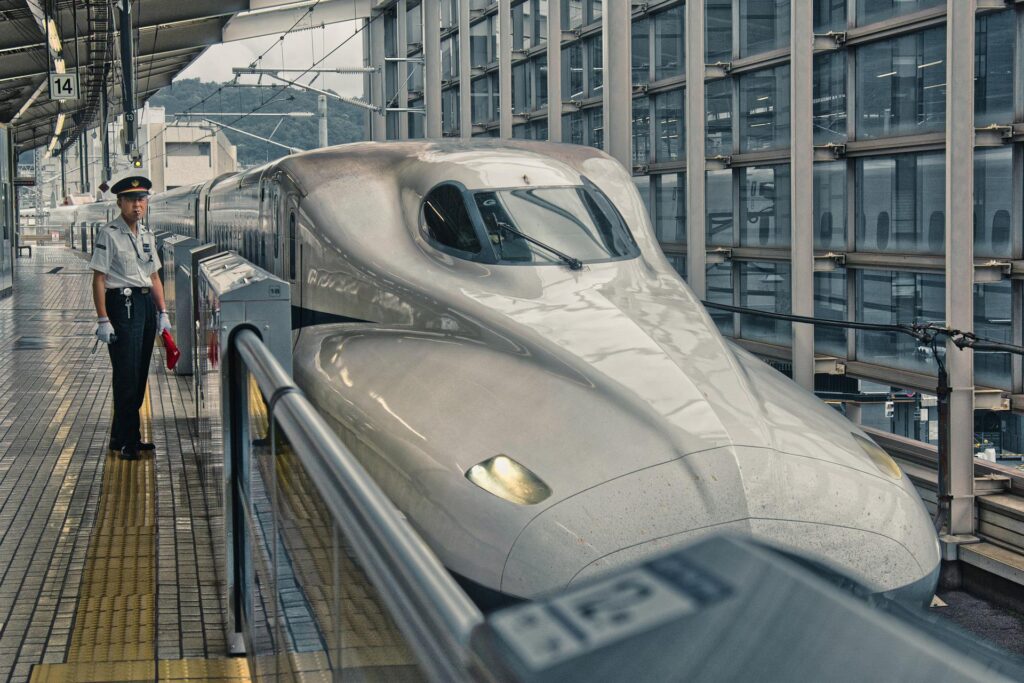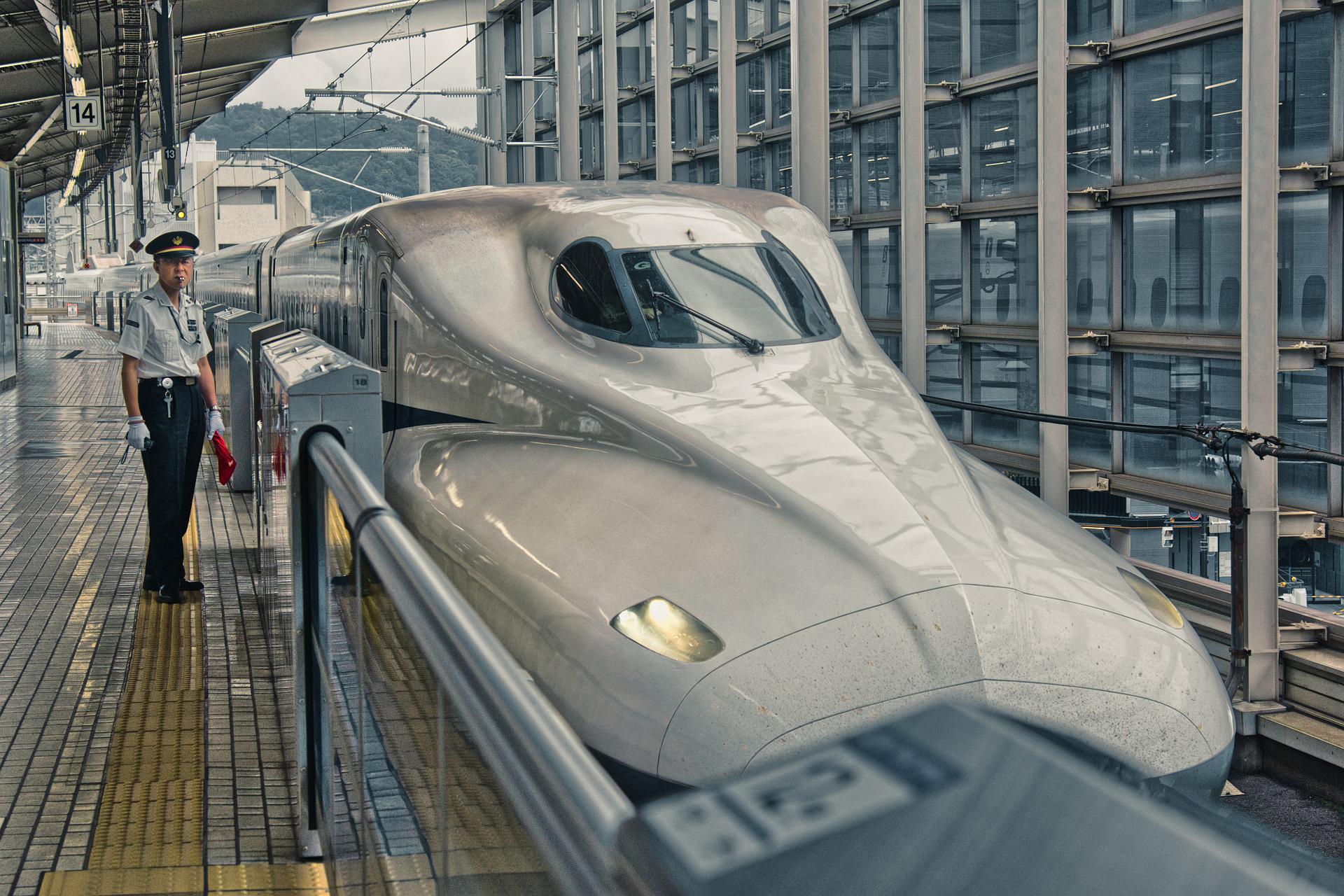Stations of Shinkansen (Bullet Train) Railway Lines
List of stations are served by Shinkansen railway lines in Japan. Some Introductions for tourists.
You can click on station name links will see detailed information for tourists, including restaurants, food, tourist attractions, hotels, and tourist information centers.

Shinkansen (Bullet Train)
The Shinkansen is Japan’s high-speed rail system, providing fast and comfortable transportation throughout the country. There are several Shinkansen lines, including the Tokaido, Sanyo, Hokkaido, Tohoku, Joetsu, and Kyushu lines, with top speeds reaching up to 320 kilometers per hour.
To ride the Shinkansen, you first need to purchase a ticket at the station. If purchasing a ticket in Japanese is difficult, you can ask the station staff for assistance in English. Some stations also have automated ticket machines for convenience. There are two types of tickets: reserved (for a designated seat) and non-reserved (first-come, first-served seating).
If you purchase a reserved ticket, you will receive a ticket with your assigned car and seat numbers. If you purchase a non-reserved ticket, you can choose any available seat.
There are also food and drink options available for purchase on the train, but you can also bring your own snacks and drinks. The trains also have restrooms and power outlets for convenience.
The Shinkansen is a great way to efficiently travel between Japan’s popular tourist destinations, making it a highlight of many foreign visitors’ trips to Japan.
Hokkaido Shinkansen(北海道新幹線)
The Hokkaido Shinkansen is one of Hokkaido’s representative railroad lines and a very convenient means of transportation for sightseeing. The route will run between major cities in Hokkaido. A route has already opened from Shin-Aomori Station to Shin-Hakodate-Hokuto Station, and a line connecting the cities of Sapporo and Hakodate is currently under construction.
Hakodate is a port city located in the southern part of Hokkaido and has a long history, having opened its port from the end of the Edo period to the Meiji period. Mount Hakodate offers a panoramic view of the city and has been selected as one of the three best night views in Japan. The Hakodate morning market offers a wide variety of fresh seafood, allowing visitors to enjoy the local delicacies. In the center of Hakodate, there is Seikan-gai, a district of retro Western-style buildings, which can be enjoyed just by strolling around. The city is also a convenient base for sightseeing in Hokkaido, with tourist attractions such as Onuma National Park and Goryokaku in the surrounding area.
Tohoku Shinkansen(東北新幹線)
The Tohoku Shinkansen Line has a route from Tokyo to Aomori City, with Morioka City and Sendai City located along the way. Morioka City offers a wealth of natural and cultural heritage sites such as Mt. Iwate and the town of Hiraizumi, while Sendai City offers a wealth of history and art sites such as the Miyagi Prefectural Art Museum and the ruins of Sendai Castle.
The Tohoku Shinkansen allows you to travel through various areas of the Tohoku region in a short time, making it very convenient when planning your sightseeing. The Tohoku region is a region with beautiful nature in all four seasons, and there are many sightseeing spots that can be enjoyed throughout the year, such as skiing and snowboarding in winter, hot springs in summer, and autumn foliage and flower viewing.
- Tokyo(東京)
- Ueno(上野)
- Ōmiya(大宮)
- Oyama(小山)
- Utsunomiya(宇都宮)
- Nasushiobara(那須塩原)
- Shin-Shirakawa(新白河)
- Kōriyama(郡山)
- Fukushima(福島)
- Shiroishi-Zaō(白石蔵王)
- Sendai(仙台)
- Furukawa(古川)
- Kurikoma-Kōgen(くりこま高原)
- Ichinoseki(一ノ関)
- Mizusawa-Esashi(水沢江刺)
- Kitakami(北上)
- Shin-Hanamaki(新花巻)
- Morioka(盛岡)
- Iwate-Numakunai(いわて沼宮内)
- Ninohe(二戸)
- Hachinohe(八戸)
- Shichinohe-Towada(七戸十和田)
- Shin-Aomori(新青森)
Akita Shinkansen(秋田新幹線)
The Akita Shinkansen has a line from Tokyo to Akita City, with cities such as Sendai and Shinjo along the way. In Akita City, there are many sightseeing spots rich in natural and cultural heritage, such as Chokaisan and Kakunodate Town, while in Sendai City, there are places where visitors can experience history and art, such as the Miyagi Prefectural Museum of Art and the ruins of Sendai Castle.
The Akita Shinkansen allows you to travel to different parts of Akita Prefecture in a short time, making it very convenient for sightseeing plans. Akita Prefecture faces the Sea of Japan and has a culinary culture that allows visitors to enjoy fresh seafood. Akita Prefecture is also a region with beautiful nature in each of the four seasons, and there are many sightseeing spots that can be enjoyed throughout the year, such as skiing and snowboarding in winter, hot springs in summer, and autumn foliage and flower viewing.
Yamagata Shinkansen(山形新幹線)
The Yamagata Shinkansen is a high-speed train connecting Yamagata Prefecture, located in the Tohoku region of Japan, with the Tokyo metropolitan area.
Yamagata Prefecture faces the Sea of Japan and is home to numerous tourist destinations blessed with nature in all four seasons. In particular, Yonezawa City, famous for its cherry blossoms, Yamagata City with its hot springs and old townscape, and Sendai City with the magnificent nature of the Zao Mountain Range, offer a wide variety of sightseeing spots.
- Fukushima(福島)
- Yonezawa(米沢)
- Takahata(高畠)
- Akayu(赤湯)
- Kaminoyama-Onsen(かみのやま温泉)
- Yamagata(山形)
- Tendō(天童)
- Sakurambo-Higashine(さくらんぼ東根)
- Murayama(村山)
- Ōishida(大石田)
- Shinjō(新庄)
Joetsu Shinkansen(上越新幹線)
The Joetsu Shinkansen is a high-speed rail line connecting Tokyo and Niigata Prefecture.
There are many hot spring resorts and ski resorts on the Joetsu Shinkansen that can be visited on a day trip. Niigata Prefecture is home to many beautiful natural features, such as the coastline facing the Sea of Japan and the Joetsu Myoko National Park, which is dotted with vast lakes and marshes. Niigata Prefecture is also known as Japan’s rice-producing region, and there are many delicious gourmet foods such as Niigata rice and seafood. Typical hot spring resorts in Niigata Prefecture include Tsubame Onsen, Tsuruoka Onsen, and Yudanaka Onsen. There are also many large ski resorts, such as Joetsu International Ski Resort and Myoko Kogen Ski Resort, which are also recommended for winter sightseeing.
- Tokyo(東京)
- Ueno(上野)
- Ōmiya(大宮)
- Kumagaya(熊谷)
- Honjō-Waseda(本庄早稲田)
- Takasaki(高崎)
- Jōmō-Kōgen(上毛高原)
- Echigo-Yuzawa(越後湯沢)
- Urasa(浦佐)
- Nagaoka(長岡)
- Tsubame-Sanjō(燕三条)
- Niigata(新潟)
Hokuriku Shinkansen(北陸新幹線)
The Hokuriku Shinkansen connects Tokyo and the Hokuriku region. This Shinkansen line offers many tourist attractions where visitors can experience the natural beauty and cultural attractions of Japan.
Kenrokuen Garden, located at Kanazawa Station, is one of the most famous Japanese gardens and offers beautiful scenery. There is also the Higashi Chaya-gai, a traditional townscape in Kanazawa City. The Tateyama Kurobe Alpine Route in Toyama Station is also a place where visitors can enjoy magnificent nature and spectacular scenery.
- Tokyo(東京)
- Ueno(上野)
- Ōmiya(大宮)
- Kumagaya(熊谷)
- Honjō-Waseda(本庄早稲田)
- Takasaki(高崎)
- Annaka-Haruna(安中榛名)
- Karuizawa(軽井沢)
- Sakudaira(佐久平)
- Ueda(上田)
- Nagano(長野)
- Iiyama(飯山)
- Jōetsumyōkō(上越妙高)
- Itoigawa(糸魚川)
- Kurobe-Unazukionsen(黒部宇奈月温泉)
- Toyama(富山)
- Shin-Takaoka(新高岡)
- Kanazawa(金沢)
Tokaido Shinkansen(東海道新幹線)
The Tokaido Shinkansen is the longest Shinkansen line in Japan, connecting Tokyo and Osaka. There are many sightseeing spots along this Shinkansen line.
Fushimi Inari Taisha Shrine in Kyoto is one of the most famous shrines in Japan, featuring a tunnel-like approach lined with numerous torii gates. Nagoya Castle, located in the city of Nagoya, is one of Japan’s most historic structures and has a beautiful garden.
- Tokyo(東京)
- Shinagawa(品川)
- Shin-Yokohama(新横浜)
- Odawara(小田原)
- Atami(熱海)
- Mishima(三島)
- Shin-Fuji(新富士)
- Shizuoka(静岡)
- Kakegawa(掛川)
- Hamamatsu(浜松)
- Toyohashi(豊橋)
- Mikawa-Anjō(三河安城)
- Nagoya(名古屋)
- Gifu-Hashima(岐阜羽島)
- Maibara(米原)
- Kyōto(京都)
- Shin-Ōsaka(新大阪)
Sanyo Shinkansen(山陽新幹線)
The Sanyo Shinkansen is a railroad line located in western Japan, connecting Tokyo with Hiroshima and Fukuoka.
If you choose to visit Hiroshima on the Sanyo Shinkansen, you will see the Atomic Bomb Dome, Peace Memorial Park, Hiroshima Castle, and other tourist attractions. Setonaikai National Park and Miyajima Island are also recommended. Along the Sanyo Shinkansen line, there are also tourist destinations such as Kurashiki and Okayama. In Kurashiki, the Bikan Historical Quarter is famous for its Edo period townscape. In Okayama, there are Okayama Castle and Korakuen Garden.
- Shin-Ōsaka(新大阪)
- Shin-Kobe(新神戸)
- Nishi-Akashi(西明石)
- Himeji(姫路)
- Aioi(相生)
- Okayama(岡山)
- Shin-Kurashiki(新倉敷)
- Fukuyama(福山)
- Shin-Onomichi(新尾道)
- Mihara(三原)
- Higashi-Hiroshima(東広島)
- Hiroshima(広島)
- Shin-Iwakuni(新岩国)
- Tokuyama(徳山)
- Shin-Yamaguchi(新山口)
- Asa(厚狭)
- Shin-Shimonoseki(新下関)
- Kokura(小倉)
- Hakata(博多)
Kyushu Shinkansen(九州新幹線)
The Kyushu Shinkansen is one of the representative railroad lines in Kyushu and a very convenient means of transportation for sightseeing. It runs on a route connecting Hakata and Kagoshima, the major cities in Kyushu.
From Hakata, it is easy to access a wide variety of tourist destinations, including Yufuin and Beppu, the most famous hot spring resorts in Kyushu, and Kumamoto, a historic castle town. Kagoshima Prefecture is also home to “Sakurajima,” the most active volcano in Japan, and “Yakushima,” which is registered as a World Heritage site. Access to these tourist destinations is also convenient, and by using the Kyushu Shinkansen, more time can be spent sightseeing.
- Hakata(博多)
- Shintosu(新鳥栖)
- Kurume(久留米)
- Chikugo funagoya(筑後船小屋)
- Shin Oomuta(新大牟田)
- Shin Tamana(新玉名)
- Kumamoto(熊本)
- Shin Yashiro(新八代)
- Shin Minamata(新水俣)
- Izumi(出水)
- Sendai(川内)
- Kagoshima Chuo(鹿児島中央)

